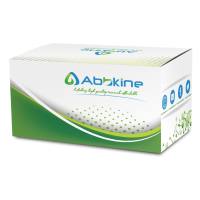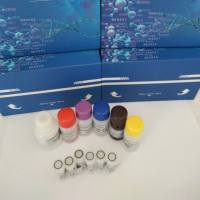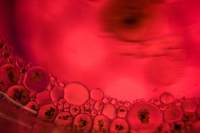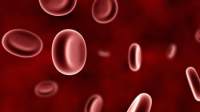核糖核酸酶保护分析实验操作步骤(英文)
互联网
- 相关专题
- 核糖核酸酶保护实验
Ribonuclease Protection Assay
contributed by James McCaughern-Carucci, Yale University
Most RNase Protection protocols require an overnight hyb with numerous subsequent clean-up steps. This method requires a maximum hyb of four hours, and the clean-up steps are the barest minimum, yet still produce nice images. It is strongly recommended to titer RNase concentrations with probes prior to running experiments...some require more RNase than others.
Part I: In Vitro Transcription
In a sterile 1.5ml microfuge tube, combine the following:
("ul"= microliter; all reagents obtained from Promega)
4 ul 5x Transcription Buffer
2 ul 0.1M DTT
4 ul 2.5mM NTP's (A, C, G)
0.8 ul RNasin RNase Inhibitor (25U/ul) (Promega)
2.4 ul of 100uM cold UTP (Note: Use 1mM UTP for loading control probes e.g. B-actin)
1 ul of 1 ug/ul linearized DNA template
5 ul of 10 uCi/ul P32 UTP (800Ci/mmol) (Dupont NEN - #NEG507X), or 1 ul for loading control probes
1ul RNA polymerase SP6,T7 or T3 (concentration varies by vendor)
Total Volume ~20ul.
Incubate 1 hour @ 37C.
Add 2ul of DNase I (Promega) to each transcription, incubate 20 minutes @ 37C.
Part II: Probe Purification
Purify probes using QIAGEN QIAquick Nucleotide Removal Kit or Boehringer Spin Columns (G50 Sephadex).
Check 1ul in scintillation counter, P32 channel. A good probe will be ~ 5x105 to 1x106 cpm.
Part III: Hybridization
Turn heatblock on to 95C.
For samples in water or ethanol, dry down appropriate amount of RNA, and include a tube with 1ul of tRNA or Glycogen (Sigma), this is the negative control.
Each sample should have the following:
24ul Formamide
2ul 0.6M PIPES
2.4ul 5M NaCl
0.3ul 0.1M EDTA
2 x105 cpm main probe
5 x104 cpm loading control probe
DEPC water
Total Volume 30ul
Mix samples well. Heat @ 95C for 10 minutes. Incubate 4 hours @ 55C.
Part IV: RNase Digestion
RNase Digestion Buffer:
300mM NaAc
10 mM TRIS
5 mM EDTA
To each sample add 350ul Digestion buffer.
Add 1ul of 4mg/ml RNase A and 0.4ul of 10u/ul RNase T1.
Incubate @ 30C for 45 minutes to 1 hour.
Part V: Proteinase K
To each sample add 10ul of 20% SDS and 2.5ul of 10mg/ml Proteinase K. Incubate @37C for 15-20 minutes.
Part VI: Clean-Up
Extract once with 400ul of Phenol/Chloroform/Isoamyl Alcohol (25:24:1)
Transfer the supernatant to a new tube. Add 1000ul of 100% ETOH and 1ul of 10mg/ml of Glycogen. Mix well.
Incubate samples at -70C for 30 minutes or in a dry ice/ETOH bath for 10 minutes.
Spin in microfuge for 15 minutes. Aspirate ETOH. Allow pellets to air dry.
Resuspend in 8ul of Formamide based loading dye. Allow to sit at RT for 5-10 minutes, with frequent mixing.
Part VII: Polyacrylamide Gel Analysis
Heat samples for 5 minutes @ 100C. Load onto a 5% polyacrylamide/7M Urea denaturing gel with 2000cpm of a molecular weight marker (dCTP labelled pBR 322 MspI digest works nicely).
Run gel @ 38-42 mA. Dry gel, expose to film O/N at -70C with an intensifying screen.
Troubleshooting and Notes
ProblemPossible Solution
No Discrete Bands, Only Smears :RNA degraded, or the the RNase Digestion was too harsh.
Try reducing the concentration of RNase A to 1 mg/ml or digest for a shorter period of time. Check your RNA for condition.
Bands Too Large, High Molecular Weight Artifacts: The RNase Digestion was inefficient and unable to effectively trim down the RNA:RNA duplexes.
Try RNasing longer or increasing the RNase concentration.
Incompletely linearized template DNA.
Bands in the Negative Control Lane:Inefficent RNase Digestion (see above).
Sense template contaminating riboprobe.
Insufficent DNase digestion of riboprobe.
Many Lower Molecular Weight Bands Under the Main Band:There can either be premature stop sites in the probe leading to smaller probe sizes, therefore smaller products. This can also stem from overdigestion by RNase A which will break-up the duplexes if the concentration or digestion time is too long.
No Signal At All: You did generate an antisense probe right?









